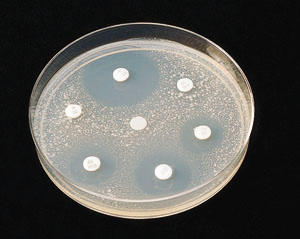BACTERIAL SENSITIVITY TO ANTIBIOTICS RECENT OVERUSE OF ANTIBIOTICS HAVE
13 SPONTANEOUS BACTERIAL EMPYEMA AN UNCOMMON COMPLICATION OF LIVER5 INFECTIONS PLEASE SELECT A TOPIC 51 ANTIBACTERIAL
91 BACTERIAL LARVICIDE TECHNICAL CONCENTRATES (TK) NOTE FOR PREPARATION
911 BACTERIAL LARVICIDE WETTABLE POWDERS (WP) NOTE FOR PREPARATION
ANTIBACTERIAL RESISTANCE – MECHANISMS PREVENTION AND IMPLICATIONS IN ICU
BACTERIAL ARTIFICIAL CHROMOSOME (BAC) MINIPREP GROW 2 ML OF
Which Antibiotic to the Rescue
Bacterial Sensitivity to Antibiotics
Recent overuse of antibiotics have lead to bacteria that are resistant to antibiotics. Are these bacteria present in the wild or only in hospitals? You will test the ability of the wild type bacteria that you have collected to grow in the presence of several antibiotics.
Materials needed for the lab
For the class:
20ml 95% ethanol 10 mg/ml ampicillian
6 sterile dishes 10 mg/ml streptomycin
Sterile water 10 mg/ml penicillin
Incubator 10 mg/ml tetracycline
Petri plate of wild type bacteria 10 mg/ml kanamyacin
Sterile Paper Disks 10 mg/ml cholamphenicol
To prepare solutions of antibiotics: make sure solutions of each antibiotic at a concentration of 10mg/ml in distilled water in a sterile flask; you will need 10ml of each solution. These will keep covered and refrigerated for several weeks
For each pair of students
1 disks to soak in sterile water
6 disks to soak in antibiotic solutions
1 nutrient agar plates
1 sterile tweezers or forceps
1 inoculating loop or swab
mm ruler
Day 1 of 2
Obtain nutrient agar plate.
Sterilize an inoculating loop in a flame, or use a cotton swab. Dip the loop or swab onto bacteria. Remove the cover on sterile nutrient agar plate. Use the sterile loop or swab to inoculate the agar plate with the bacteria by streaking the bacteria on the plate. Streak the whole plate.
Use a sharpie on the bottom of the plate to make 7 evenly spaced dots that mark the location and name of each antibiotic and control you will use. Place the disks on each of the dots (see fig). Make a drawing of each plate with the appropriate labeling in your notebook.

Use tweezers to remove 1 paper disk from each of the antibiotic solutions and 1 plain disk. Replace cover and secure with tape. (Make sure to place the disks on areas that you have streaked with bacteria).
Leave at room temp to incubate for 24-48 hours, or incubate over night at 37°C. Why 37°C?
Day 2 of 2
Look at your plates, has your bacteria grown?
Do you see an area next to any of the disks with no bacterial growth? If so, measure (with a ruler) the zone of no growth and compare to control. What is the control? Why do you need to include this control into your experiment? Calculate the area of no growth
Does some of your bacteria grow better on some of the antibiotics than others? If so which ones? Compare your data with the rest of the class. Research and discuss the possibilities as to why you might see these differences.
Bacterial Community Composition and Diversity Respond to Nutrient Amendment
BACTERIAL MENINGITIS WHAT IS MENINGITIS? MENINGITIS IS AN INFLAMMATION
BACTERIAL POLLUTION INDICATORS IN AQUATIC ENVIRONMENT AND FISH IN
Tags: antibiotics recent, the antibiotics, antibiotics, sensitivity, overuse, bacterial, recent
- ERZİNCAN BİNALİ YILDIRIM ÜNİVERSİTESİ BİRİM KALİTE SORUMLULARI LİSTESİ DOKÜMAN
- REVENUE AND EXPENDITURE POLICIES OF THE LOUISIANA STATE UNIVERSITY
- [VERSION 8 102012] DODATEK I POVZETEK GLAVNIH ZNAČILNOSTI ZDRAVILA
- ALTRUISM OR SOLIDARITY? THE MOTIVES FOR ORGAN DONATION AND
- TEXTOS LITERARIOS TEXTOS NO LITERARIOS FINALIDAD ESTÉTICA Y BELLEZA
- UNIVERZITET CRNE GORE FILOZOFSKI FAKULTET NIKŠIĆ PODACI O PRIJEMNIM
- LISTA DE PLANEAMIENTO DE OPORTUNIDADES META(S) GENERALES
- IL PESSIMISMO DELLA RAGIONE CLAUDE CHABROL E MICHAEL HANEKE
- NA OSNOVU ČLANA 39 STATUTA UNIVERZITETA CRNE GORE VIJEĆE
- SYLLABUS FOR EDF 6938798—APPLIED BEHAVIOR ANALYSIS BASIC PRINCIPLES 1
- NOTA INFORMATIVA REAL DECRETOLEY 242020 MEDIDAS SOCIALES DE REACTIVACIÓN
- EFECTOS PSICOLÓGICOS Y ESPIRITUALES DE LA MÚSICA POR DR
- EL MUSEO JULIO CARO BAROJA PROGRAMA UNA EXPOSICIÓN SOBRE
- T OILETING RECORDING CHART DATE NAME DATE OF BIRTH
- TEKUK (BUCKLING KNIK) PADA KOLOM KAPASITAS PIKUL BEBAN PADA
- HER MAJESTY QUEEN ELIZABETH II 90TH BIRTHDAY CELEBRATIONS GRANT
- 1709 E SARAH DEWITT DR GONZALES TEXAS 78629 DECEMBER
- FAONETHERLANDS INTERNATIONAL CONFERENCE WATER FOR FOOD AND ECOSYSTEMS MAKE
- MR DUNCAN MACKENZIE OAM 4 EDINBURGH AVENUE STONYFELL SA
- EXPLORATION AND PRODUCTION ACTIVITIES IN NORTHERN ADRIATIC SEA (CROATIA)
- AMAZING GRACE LYRICS AMAZING GRACE HOW SWEET THE SOUND
- INTRODUCTIE DEUS CARITAS EST EN DE KATHOLIEKE SOCIALE LEER
- D&C JRCLMM SECTION 220577 FLOOR AND AREA DRAINS SEE
- (IME I PREZIME RODITELJA PODNOSITELJA ZAHTJEVA) (ADRESA
- ……………………………………………… ……………………………… IMIĘ I NAZWISKO LEKARZALEKARZA DENTYSTY MIEJSCOWOŚĆ DATA
- REGISTRO DE ENTREGA EPI CENTROINSTITUTO DEPARTAMENTO NOMBRE Y APELLIDOS
- LA COSTUMBRE COMO FUENTE DEL DERECHO MARTÍN CALLEJA I
- UNIVERSITY OF TEXAS SCHOOL OF LAW STUDY ABROAD
- CSD 424 [12115] NAME ADDRESS TELEPHONE NO & ID
- RENCONTRES EURO MÉDITERRANÉENNES 2009 DES FORMATIONS SUR LES RISQUES
 CHAPTER 15 THE ATMOSPHERE UNIT 4 QUIZ 2 MULTIPLE
CHAPTER 15 THE ATMOSPHERE UNIT 4 QUIZ 2 MULTIPLE GREENE® ENERGY ATTESTATION FROM GENERATOR PARTICIPATING IN A TRACKING
GREENE® ENERGY ATTESTATION FROM GENERATOR PARTICIPATING IN A TRACKING CERTIFICATE OF ARRIVAL CONECTOR RECTO 9 NAME OF THE
CERTIFICATE OF ARRIVAL CONECTOR RECTO 9 NAME OF THEDEPARTMENT OF HUMAN SERVICES DIVISION OF DEVELOPMENTAL DISABILITIES ANNEX
ADATLAP A CSEPREGHU HONLAPHOZ CSEPREGI VÁLLALKOZÓK VÁLLALKOZÁSOK CÉGEK RÉSZÉRE
 WWWLARIOJAORG GOBIERNO DE LA RIOJA PROCEDIMIENTO DE MOVILIDAD PARA
WWWLARIOJAORG GOBIERNO DE LA RIOJA PROCEDIMIENTO DE MOVILIDAD PARAPARSONAGE GUIDELINES THESE PROPOSALS FOR PARSONAGE GUIDELINES IN THE
AMATŐR SPORTOLÓI SZERZŐDÉS MELY LÉTREJÖTT EGYRÉSZT A(Z) ………………………………………………………………………………………… TOVÁBBIAKBAN
 PODROBNÁ ZPRÁVA O PROJEKTU PRAŽSKÉ VĚŽE V ROZMEZÍ LET
PODROBNÁ ZPRÁVA O PROJEKTU PRAŽSKÉ VĚŽE V ROZMEZÍ LET FREQUENTLY ASKED QUESTIONS FOR RESIDENTS WHAT IS THE BLACKBOARD
FREQUENTLY ASKED QUESTIONS FOR RESIDENTS WHAT IS THE BLACKBOARDACP WGN04 NEWORLEANS LIST OF PARTICIPANTS WORKING
DEPARTMENT OF COMPUTER SCIENCE ABOUT THE DEPARTMENT THE
DOMINGO V TIEMPO ORDINARIO CICLO C HOMILÍAS JOSÉ ANTONIO
 TANQUES DE ALMACENAMIENTO LA DIRECCIÓN RED MATRIZ ACUEDUCTO PARA
TANQUES DE ALMACENAMIENTO LA DIRECCIÓN RED MATRIZ ACUEDUCTO PARACEREBROSPINAL FLUID (CSF) CELL COUNT AND DIFFERENTIAL CYTOCENTRIFUGE TECHNIQUE
 FRAME1 EL PASADO 31 DE DICIEMBRE SE PUBLICÓ EL
FRAME1 EL PASADO 31 DE DICIEMBRE SE PUBLICÓ ELVENEZUELA INFORME PARA LA ASAMBLEA DE LA SIP OCTUBRE
FIRST SEMESTER 1LS – TAKE A TOUR OF THE
COMPRA IMÓVEL JUNTO À CEF A QUEM CONFERE
L4199 MODIFICA INCXXIX DEL ART1 L257 COTE LAI